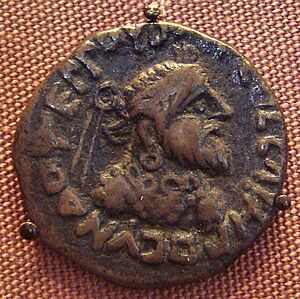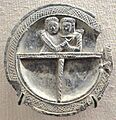Indo-Parthian Kingdom facts for kids
Quick facts for kids
Indo-Parthian Kingdom
|
|||||||||||||||||||
|---|---|---|---|---|---|---|---|---|---|---|---|---|---|---|---|---|---|---|---|
| 19 CE–226 CE | |||||||||||||||||||
| Common languages | Aramaic Greek Pali (Kharoshthi script) Sanskrit, Prakrit (Brahmi script), Parthian |
||||||||||||||||||
| Religion | Buddhism Hinduism Zoroastrianism |
||||||||||||||||||
| Government | Monarchy | ||||||||||||||||||
| King | |||||||||||||||||||
|
• 19–46
|
Gondophares I (first) | ||||||||||||||||||
|
• ?–226
|
Farn-Sasan (last) | ||||||||||||||||||
| Historical era | Antiquity | ||||||||||||||||||
|
• Gondophares I
|
19 CE | ||||||||||||||||||
|
• Disestablished
|
226 CE | ||||||||||||||||||
|
|||||||||||||||||||
The Indo-Parthian Kingdom was an ancient kingdom that existed from about 19 CE to 226 CE. It was founded by a ruler named Gondophares. At its strongest, this kingdom covered parts of eastern Iran, areas of Afghanistan, and the northwestern parts of the Indian subcontinent. This included most of modern Pakistan and some areas of northwestern India.
The rulers of this kingdom might have been part of the House of Suren, a powerful family. Some historians even call it the "Suren Kingdom." The kingdom began when Gondophares, who was a governor in a region called Drangiana (modern Sistan), declared his independence from the larger Parthian Empire.
Gondophares then expanded his kingdom by conquering lands from the Indo-Scythians and Indo-Greeks. This turned his kingdom into a small empire. However, the Indo-Parthian lands became much smaller after the Kushans invaded in the second half of the 1st century CE. The Indo-Parthians managed to keep control of Sakastan until the Sasanian Empire conquered it around 224/5 CE.
The Indo-Parthians are famous for building the Buddhist monastery Takht-i-Bahi in Mardan, Pakistan. This site is now recognized as a UNESCO World Heritage Site.
Contents
Gondophares I and His Kingdom
Gondophares I started as a ruler in Seistan, which is in modern-day eastern Iran. He was likely a local leader or a relative of the Apracarajas, another ruling family. He probably took over from earlier Parthian governors in the region of Sakastan. These governors had been in charge since Mithridates II of Parthia defeated the Sakas people.
Around 20–10 BCE, Gondophares conquered parts of the former Indo-Scythian kingdom. This happened possibly after the death of an important ruler named Azes. Gondophares became the ruler of areas like Arachosia, Seistan, Sindh, Punjab, and the Kabul valley. However, he probably didn't control lands beyond eastern Punjab.
Gondophares called himself "King of Kings." This was a Parthian title. For him, it meant that his empire was a loose collection of smaller states. Many local rulers likely kept their power by agreeing to recognize Gondophares and his successors as their main leaders. These local rulers included the Apracarajas and Indo-Scythian governors (called satraps) like Zeionises.

After Gondophares I died, his empire began to break apart. Other rulers used the name or title Gondophares. For example, Sarpedones became Gondophares II. He was possibly the son of the first Gondophares. Even though he claimed to be the main ruler, Sarpedones' power was weak. He issued coins in only a few areas like Sind and southern Afghanistan.
The most important successor was Abdagases, who was Gondophares' nephew. He ruled in Punjab and possibly in Seistan. Later, a king named Sases took over Abdagases' lands and became Gondophares IV Sases. This is likely the Gondophares mentioned in the Takht-i-Bahi inscription.
The Indo-Parthians never became as powerful as Gondophares I again. From the middle of the 1st century CE, the Kushans under Kujula Kadphises began to take over the northern Indian parts of the kingdom.
End of the Indo-Parthian Kingdom
The Indo-Parthians managed to hold onto control of regions like Turan and Sakastan. They ruled these areas until the Parthian Empire fell to the Sasanian Empire around 230 CE. Pahares I (160-230 CE) was a ruler of Turan after the Indo-Parthian kingdom split up. The kingdom of Sakastan was ruled by another king named Sanabares II (160-175 CE).
The kingdoms of Turan and Sakastan ended when they surrendered to the Sasanian ruler Ardeshir I around 230 CE. This event was recorded by the historian Al-Tabari. He wrote about envoys from the kings of Kushan, Turan, and Mokran coming to Ardeshir to declare their submission.
Archaeological Discoveries

The ancient city of Taxila is believed to have been a capital of the Indo-Parthians. Archaeologist Sir John Marshall excavated large areas there. He found many artifacts in the Parthian style. The nearby temple of Jandial is often thought to be a Zoroastrian fire temple from the time of the Indo-Parthians.
Some old writings also mention the Indo-Parthians. One story is about Saint Thomas the Apostle. He was supposedly hired as a carpenter to work for a king named "Gudnaphar" in India. This king is thought to be Gondophares. The Acts of Thomas describes Thomas's visit to king Gudnaphar in northern India. It also says he traveled by sea to India, suggesting a connection to the west coast.
Historians debate if this story is true. If it is, Saint Thomas might have met one of the later kings who used the same title, as Gondophares I might have lived before Christianity began.
The Greek philosopher Apollonius of Tyana is said to have visited India around 46 CE. This is mentioned by Philostratus in his book Life of Apollonius Tyana. Apollonius described Greek-style buildings in Taxila, likely referring to the city of Sirkap. He also said that the Indo-Parthian king of Taxila, named Phraotes, had a Greek education and spoke Greek very well.
The Periplus of the Erythraean Sea is a guide from the 1st century CE about sea routes in the Arabian Sea. It describes Parthian kings fighting each other in the region of Sindh. This area was known as "Scythia" because the Indo-Scythians had ruled there before. The guide mentions that the city of Minnagara was "subject to Parthian princes who are constantly driving each other out."
Indo-Parthian Culture and Art
Religion of the Indo-Parthians

We don't know the exact religion of the Suren family, but they were in conflict with the Zoroastrian Arsacid dynasty. Unlike the Indo-Greeks or Indo-Scythians, there aren't many clear records showing Indo-Parthian rulers supporting Buddhism. Their coins usually followed Greek styles but didn't show Buddhist symbols like the triratna (except for a later ruler named Sases). They also didn't use images of elephants or bulls, which were common religious symbols for earlier rulers.
It is thought that the Indo-Parthians kept their original religion, Zoroastrianism, since they came from Iran. This Iranian belief system was later adopted by the Kushans, who ruled from the Peshawar region of Pakistan. Coins showing the Hindu god Shiva have also been found from the time of Gondophares I.
Indo-Parthian Clothing and Appearance
On their coins and in the art of Gandhara, Indo-Parthians are shown wearing short crossover jackets and large baggy trousers. They might have also worn chap-like over-trousers. Their jackets often had rows of decorative rings or medals. Their hair was usually bushy and held in place with a headband. This style became common for Parthians from the 1st century CE.
People wearing Indo-Parthian clothes are sometimes seen in Buddhist art. Many artifacts found at Sirkap near Taxila by John Marshall are believed to be from the Indo-Parthian period. These findings include Greek-style items mixed with Buddhist worship objects like stupas.
Buddhist Sculptures
The statues found at Sirkap, from layers dating between 1 and 60 CE, show that Gandharan art was already well-developed during or even before Parthian rule. Many statues were found, including Greek gods, local Gandharan people, and what are believed to be early images of the Buddha and Bodhisattvas. It's still not clear exactly when Greco-Buddhist art in Gandhara began, but the discoveries at Sirkap suggest it was quite advanced before the Kushans arrived.
Stone Palettes
Many stone palettes found in Gandhara are considered great examples of Indo-Parthian art. These palettes mix Greek and Persian styles. They often show figures facing directly forward, which is a common feature of Parthian art. Such palettes have only been found in archaeological layers from the Indo-Greek, Indo-Scythian, and Indo-Parthian periods. They are not found in earlier Mauryan layers or later Kushan layers.
These palettes often show people in Greek clothing in scenes from mythology. However, some show people in Parthian dress. This includes headbands over bushy hair, crossover jackets on bare chests, jewelry, belts, and baggy trousers. One palette from the Naprstek Museum in Prague shows an Indo-Parthian king sitting cross-legged on a large sofa. He is surrounded by two attendants, also in Parthian clothing, who are drinking and serving wine.
Silk Road and Buddhism

Even after the Sassanids took over in 226 CE, some small areas of Parthian rule remained in the East. From the 2nd century CE, several Buddhist missionaries from Central Asia traveled to Chinese capital cities like Luoyang and Nanjing. They became famous for translating Buddhist texts into Chinese.
The first known translators of Buddhist texts into Chinese were actually Parthian missionaries. They were known in Chinese by their Parthian surname "An," which stood for "Anshi," meaning "country of the Arsacids" (the Parthian ruling family).
- An Shih Kao was a Parthian prince. He made the first known translations of Hinayana Buddhist texts into Chinese (148–170 CE).
- An Hsuan was a Parthian merchant who became a monk in China in 181 CE.
- Tan-ti (around 254 CE) was another Parthian monk.
- An Fajin (281–306 CE) was a monk of Parthian background.
Main Indo-Parthian Rulers
- Gondophares I (c. 19 – 46 CE) Coin
- Gondophares II Sarpedones (early 1st century CE – c. 20 CE)Coin
- Abdagases I (early 1st century CE – mid-1st century CE) Coin
- Gondophares III Gudana, previously Orthagnes (c. 20 CE – 30 CE)
- Gondophares IV Sases, (mid-1st century CE)
- Ubouzanes, (late-1st century CE)
- Pacores (late 1st century CE) Coin
Images for kids
See also
- Indo-Greek Kingdom
- Indo-Sasanians
- Indo-Scythians
- Kushan Empire
- Yuezhi
- Pahlavas
- Kambojas










